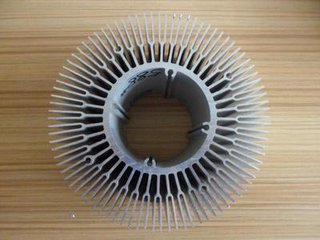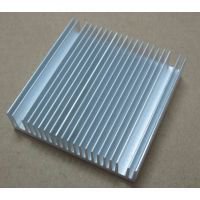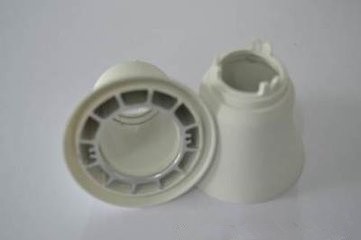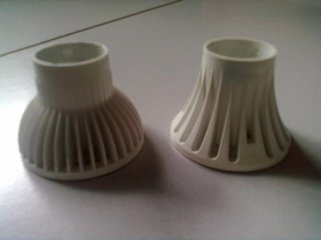At present, one of the most significant technical challenges in LED lighting fixtures is heat dissipation. Heat generated by LEDs and electrolytic capacitors often leads to the early aging of LED light sources, posing a major obstacle to their long-term development. To address this issue, it is essential to efficiently remove heat from the LED lamp, thereby reducing the internal cavity temperature and preventing the power supply from operating under prolonged high temperatures. This helps to extend the lifespan of LED light sources and maintain their performance.
LEDs themselves do not emit infrared or ultraviolet rays, meaning they lack natural radiation-based heat dissipation mechanisms. Consequently, the heat dissipation pathway in LED lighting fixtures relies heavily on heat sinks that are closely coupled with the LED chips. An effective heat sink must possess three primary functions: thermal conduction, thermal convection, and thermal radiation.
In any heat sink, the ability to quickly transfer heat from the heat source to the surface is critical. However, the main role of a heat sink lies in its capacity for convective and radiative heat dissipation into the surrounding air. While thermal conduction establishes the path for heat transfer, thermal convection is the primary mechanism for removing heat. The effectiveness of heat dissipation depends largely on the surface area, shape, and natural convection strength of the heat sink. Thermal radiation serves as a supplementary function. Generally speaking, if the distance between the heat source and the heat sink's surface is less than 5mm, materials with a thermal conductivity greater than 5 can efficiently conduct heat away. Beyond that, heat convection becomes the dominant factor.
Most LED light sources still utilize low-voltage (VF=3.2V), high-current (IF=200-700mA) LED chips. During operation, these generate substantial heat, necessitating the use of aluminum alloys with high thermal conductivity. Common materials include die-cast aluminum, extruded aluminum, and stamped aluminum. Die-cast aluminum radiators involve a pressure casting process where molten zinc-copper-aluminum alloy is poured into a die-casting machine and cast into a pre-designed mold, forming a specific shape.
Below is a comparative analysis of five types of radiators:
**Die-cast Aluminum Radiator**

This type of radiator offers controlled production costs but struggles to create thin heat dissipation fins, limiting the maximization of heat dissipation area. Common die-cast materials include ADC10 and ADC12.
**Extruded Aluminum Radiator**

Liquid aluminum is extruded through a fixed mold and then machined into the desired heat sink shape. The extrusion process results in high machining costs. The extruded aluminum heat sink can have numerous thin fins, maximizing the heat dissipation area. Air convection naturally forms when the fins work, enhancing heat dissipation. Common materials are AL6061 and AL6063.
**Stamped Aluminum Radiator**

Stamped aluminum radiators are created by punching and pulling steel and aluminum alloy sheets using stamping machines and molds. These radiators have smooth inner and outer peripheries but lack fins, limiting their heat dissipation area. Common materials include 5052, 6061, and 6063. Stamping parts are lightweight and have high material utilization, making them a cost-effective solution.
Aluminum alloy heat sinks offer excellent thermal conductivity and are suitable for isolated switching constant current power supplies. For non-isolated switching constant current power supplies, the structural design of the luminaire must ensure the separation of AC and DC, high and low voltages, to meet CE or UL certification standards.
**Plastic-Aluminum Radiator**

This radiator features a heat-conductive plastic outer casing with an aluminum core. The heat-conductive plastic and aluminum core are formed together on an injection molding machine, requiring pre-machining of the aluminum core. The heat from the LED chip is quickly transferred to the heat-conductive plastic via the aluminum core. The heat-conductive plastic uses its multi-wings to form air convection heat and radiates some heat through its surface.
Plastic-coated aluminum heat sinks typically use the original colors of the heat-conductive plastic, white or black. Black plastic-coated aluminum heat sinks provide better radiative heat dissipation. Thermally conductive plastics are thermoplastic materials that are easy to injection mold, offering good resistance to thermal shock cycles and excellent insulation properties. They have better emissivity than ordinary metallic materials. The density of thermally conductive plastic is 40% lower than that of die-cast aluminum and ceramics. A heat sink of the same shape weighs nearly one-third less than an all-aluminum heat sink. Compared to all-aluminum heat sinks, plastic-coated aluminum heat sinks have lower processing costs, shorter processing cycles, and lower processing temperatures. The finished product is less prone to breakage, and customers can design differentiated shapes of lamps using their own injection molding machines. Plastic-coated aluminum heat sinks have good insulation properties, making them easier to pass safety regulations.
**High Thermal Conductivity Plastic Radiator**

High thermal conductivity plastic radiators have developed rapidly in recent years. These radiators are entirely plastic-based and exhibit thermal conductivity several times higher than ordinary plastics, reaching up to 2-9 W/mK. They possess excellent heat conduction and radiation capabilities. This new insulating heat dissipation material can be applied to various power lamps and is widely used in LED lamps ranging from 1W to 200W.
High thermal conductivity plastic can withstand up to 6000V AC, making it suitable for non-isolated switching constant current power supplies and HVLED high-voltage linear constant current power supplies. This type of LED lighting fixture easily passes stringent safety inspections such as CE, TUV, and UL. HVLED operates at high voltage (VF=35-280 VDC) and low current (IF=20-60 mA), significantly reducing LED heat generation. High thermal conductivity plastic radiators can be produced using traditional injection molding and extrusion machines. The finished product has a high finish, improving production efficiency and offering high design flexibility. High thermal conductivity plastic radiators are made from PLA (corn starch) polymers, are fully degradable, leave no residue, and cause no chemical or heavy metal pollution during production, aligning with global environmental protection standards.
High thermal conductivity plastic heat sinks contain densely packed nano-scale metal ions within the PLA that move at high temperatures, increasing heat radiation energy. Their vitality surpasses that of metal materials. High thermal conductivity plastic heat sinks are resistant to high temperatures, showing no breakage or deformation at 150°C for five hours. They are compatible with high-voltage linear constant current IC drive schemes, eliminating the need for electrolytic capacitors and large inductors, thus greatly extending the life of LED lamps. Non-isolated power solutions offer high efficiency and low cost, making them particularly suitable for fluorescent tube and high-power mining lamp applications.
High thermal conductivity plastic heat sinks can be designed with numerous precise cooling fins. The fins can be made very thin, maximizing the heat dissipation area. When the fins work, air convection naturally forms, improving heat dissipation. The heat from the LED chips passes directly to the heat sink through the highly thermally conductive plastic, which dissipates heat quickly through air convection and surface radiation.
High thermal conductivity plastic heat sinks are lighter than aluminum. Aluminum has a density of 2700kg/m³, whereas plastic has a density of 1420kg/m³, almost half that of aluminum. Thus, a heat sink of the same shape weighs only half as much as an aluminum one. Moreover, the processing is simpler, shortening the molding cycle by 20-50%, which reduces costs.
PUFF SERIES
Sporting a 550mAh battery and direct draw system, the Puff Bar PLUS has enough power to deliver excellent flavor without any charging or complicated settings. PUFF PLUS has double the PUFFS, making it the longest-lasting disposables out in the market. Just inhale to fire up the pre-filled device. After your PUFF BAR PLUS runs out of juice and/or battery, simply buy a replacement.
Specifications and Features:
- Disposable Device requires No Maintenance, Charging or Refilling
- Pre-Filled: 3.2mL Salt Nic
- Internal Battery: 550mAh
- Pre-charged, Simply puff on the device to activate
- Pre-filled, no need for messy refills
- Salt Nicotine: 5%, (50MG) Salt Nic inside for an accurate cigarette-style throat hit
- Up to 800+ Puffs per disposable, approximately equivalent to 2 pack of cigarettes (40 cigarettes)
Puffs Cartoon Series E-Cigarette,Puff Plus Puff Bar,Puff Series With Safe Ingredients,Disposable Puff Series Vape Pen
Shenzhen Ousida Technology Co., Ltd , https://www.osdvape.com